When American hunters go for the ocellated turkey, they want an adult male specimen to bring home for mounting. Sex and age identification of ocellated turkeys can be difficult because both sexes have the same brightly colored plumage. The only infallible identifying feature of the adult male that can be seen under normal hunting conditions is his well developed "crown."
The adult male ocellated turkey ("pavo" in Spanish) has a fleshy appendage on the top of his head that looks like a crown. It is present all year but enlarges in spring. The crown stands straight up and is dotted with small, round, orange-colored caruncles. At suitable shotgun range, the crown is easy to see. The photographs tell the story.

If you can't see a male's crown, you may be looking at a jake or a hen.
Other
Physical Features
The ocellated
turkey does not have a beard. The male ("macho") has very long, sharp
spurs but the spurs are rarely visible because of vegetation and distance.
The male is larger than the female ("hembra" pronounced "embra") but a direct comparison is usually not possible. Adult males and jakes ("joven" pronounced "hoven") are about the same height. Although jakes are lighter in body weight than adult males, that is not a useful distinguishing feature until you put them on the scales which is too late for it to matter. Since jakes are distinctly taller than hens, it is not safe to shoot the largest turkey assuming it is an adult male when two or more are seen together.
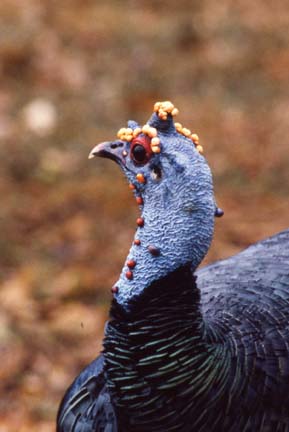
The Head of an Adult Male Showing
the Well Developed Crown on Top

Sex ID can be difficult in the dim light of early morning. This is a
hen on the roost.
Some outfitters permit their guides to shoot turkeys on the roost in the dark with a spotlight. This is a good way to shoot a hen by mistake and it is easy to miss a turkey if you are not practiced at shooting in the dark with a spot light. I do not recommend shooting in the dark and we discourage it in our camps. If you approach a roosting adult male in the dark of morning, merely get well hidden in gun range and wait for daylight. He will usually sing for you to confirm his identity.
The male's mating call is his song ("canto" pronounced "conto"). He will sing from time to time in early morning and late afternoon and sometimes will be seen strutting and singing if a hen is nearby. But singing and strutting behavior are not 100% reliable indicators of age class ID because jakes occasionally sing and strut. Hens do not strut or sing.
In good daylight at reasonable shotgun range, the enlarged crown of the adult male can be seen. If you don't see a distinct crown, do not shoot or you may be taking home a jake for your trophy or have to pay an extra trophy fee.
Native guides often locate adult males on the roost by hearing them singing in late afternoon and spotting them on the tree limb at flying up time. It is unusual for hens to be in the same tree with an adult male but hens do sometimes roost in the same trees with jakes.
Click here to go to the page where you can hear the male's mating song.

A Displaying Male Stretches his Neck Above the Hen
and Issues a Barely Audible, Low-Pitched "ooooo" Sound.
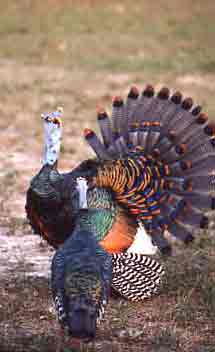
The Ocellated Male Raises His Head to Sing his Mating Song
(the Equivalent of Gobbling) from Time to Time While Strutting
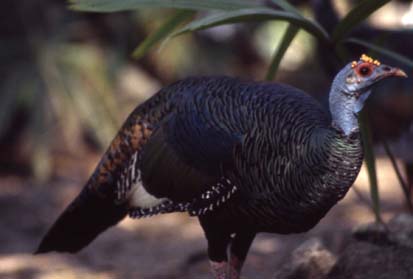
An Adult Hen with the Same Brightly Colored Plumage as the Male
When an adult male is being stalked on his morning roost before daylight, your guide may have reliable knowledge that the bird is an adult male based on his singing behavior observed the evening before. However, the guide may have heard a male song but may not have ascertained exactly where the male was and he could lead you to a hen in a nearby tree. Be sure that the guide is questioned about his level of certainty before you shoot at a roosting bird in poor light.
If the guide is certain that he knows the limb the turkey in on and certain that it is an adult male because of its singing behavior, it is safe to shoot the bird. Otherwise, it is not.
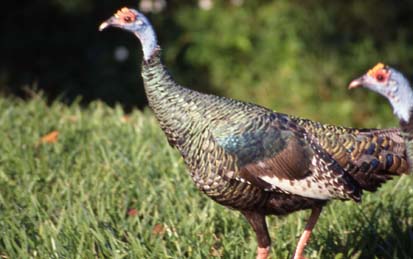 The Head of a Jake Showing the Undeveloped Crown |
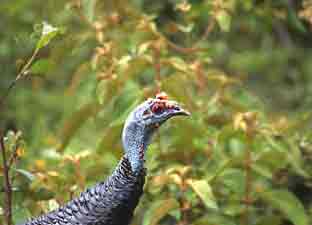 Another Jake with Undeveloped Crown |
When Calling to
an Adult Male
When using
a calling device, you are almost certainly going to hear the male singing
before and during his approach to your position. Still, it is a good idea
to confirm his sex and age status by seeing his crown or observing his
singing posture because he may be accompanied by a hen or jake and they
may come to you before the adult male does.
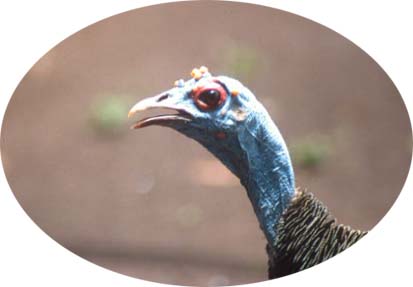
The Head of a Hen Showing No Crown